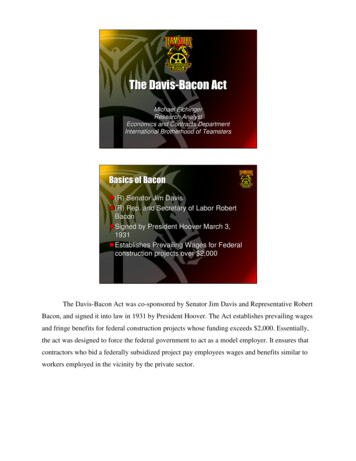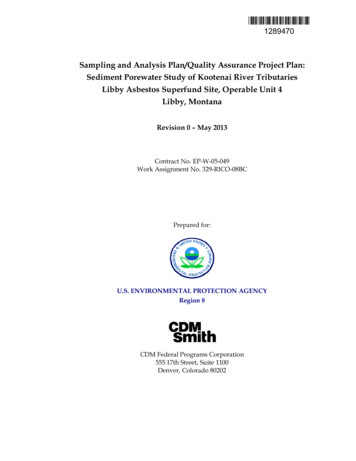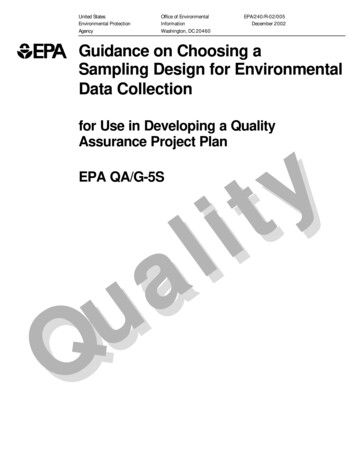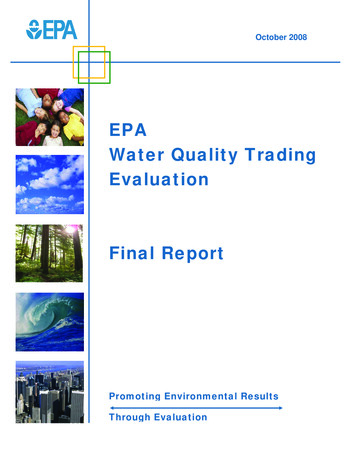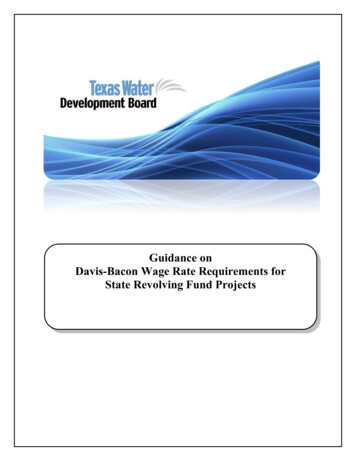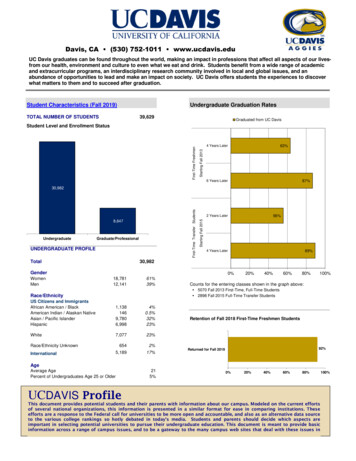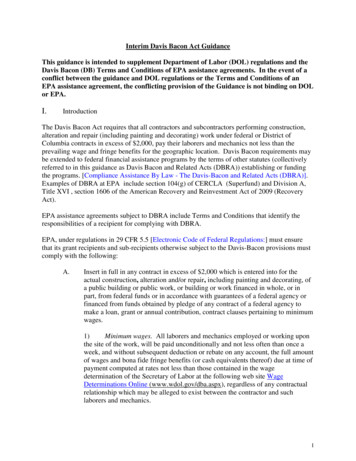
Transcription
Interim Davis Bacon Act GuidanceThis guidance is intended to supplement Department of Labor (DOL) regulations and theDavis Bacon (DB) Terms and Conditions of EPA assistance agreements. In the event of aconflict between the guidance and DOL regulations or the Terms and Conditions of anEPA assistance agreement, the conflicting provision of the Guidance is not binding on DOLor EPA.I.IntroductionThe Davis Bacon Act requires that all contractors and subcontractors performing construction,alteration and repair (including painting and decorating) work under federal or District ofColumbia contracts in excess of 2,000, pay their laborers and mechanics not less than theprevailing wage and fringe benefits for the geographic location. Davis Bacon requirements maybe extended to federal financial assistance programs by the terms of other statutes (collectivelyreferred to in this guidance as Davis Bacon and Related Acts (DBRA)) establishing or fundingthe programs. [Compliance Assistance By Law - The Davis-Bacon and Related Acts (DBRA)].Examples of DBRA at EPA include section 104(g) of CERCLA (Superfund) and Division A,Title XVI , section 1606 of the American Recovery and Reinvestment Act of 2009 (RecoveryAct).EPA assistance agreements subject to DBRA include Terms and Conditions that identify theresponsibilities of a recipient for complying with DBRA.EPA, under regulations in 29 CFR 5.5 [Electronic Code of Federal Regulations:] must ensurethat its grant recipients and sub-recipients otherwise subject to the Davis-Bacon provisions mustcomply with the following:A.Insert in full in any contract in excess of 2,000 which is entered into for theactual construction, alteration and/or repair, including painting and decorating, ofa public building or public work, or building or work financed in whole, or inpart, from federal funds or in accordance with guarantees of a federal agency orfinanced from funds obtained by pledge of any contract of a federal agency tomake a loan, grant or annual contribution, contract clauses pertaining to minimumwages.1)Minimum wages. All laborers and mechanics employed or working uponthe site of the work, will be paid unconditionally and not less often than once aweek, and without subsequent deduction or rebate on any account, the full amountof wages and bona fide fringe benefits (or cash equivalents thereof) due at time ofpayment computed at rates not less than those contained in the wagedetermination of the Secretary of Labor at the following web site WageDeterminations Online (www.wdol.gov/dba.aspx), regardless of any contractualrelationship which may be alleged to exist between the contractor and suchlaborers and mechanics.1
A “wage determination” is the listing of wage and fringe benefit for eachclassification of laborers and mechanics which the Administrator of the Wage andHour Division of the U.S. Department of Labor has determined to be prevailing ina given area for a particular type of construction (e.g., building, heavy, highway,or residential).The wage determination (including any additional classification and wage rates)and the Davis-Bacon poster (WH–1321) shall be posted at all times by thecontractor and its subcontractors at the site of the work in a prominent andaccessible place where it can be easily seen by the /posters/fedprojc.pdf2)Withholding. In the event of failure to pay any laborer or mechanic,including any apprentice, trainee, or helper, employed or working on the site ofthe work, all or part of the wages required by the regulations, the loan or grantrecipient may, after written notice to the contractor, sponsor, applicant, or owner,take such action as may be necessary to cause the suspension of any furtherpayment, advance, or guarantee of funds until such violations have ceased.3)Payrolls and basic records. Payrolls and basic records relating theretoshall be maintained by the contractor during the course of the work and preservedfor a period of three years thereafter for all laborers and mechanics working at thesite of the work. The contractor shall submit weekly for each week in which anycontract work is performed, a copy of all payrolls to the recipient, sponsor, orowner. The required weekly payroll information may be submitted in any formdesired. A contractor may use Form WH–347 which is available from the Wageand Hour Division web site at: tracts. The prime contractor is responsible for the compliance byany subcontractor or lower tier subcontractor with the requirements above, therequirements identified in the Davis Bacon Terms and Conditions of the EPAassistance agreement, and the contract clauses in 29 CFR 5.5.B.Contract Work Hours and Safety Standards Act. In any contract in an amount inexcess of 100,000 and subject to the overtime provisions of the Contract WorkHours and Safety Standards Act, the following clauses shall apply:1)Overtime requirements. No contractor or subcontractor for any part of thecontract work which may require or involve the employment of laborers ormechanics shall require or permit any such laborer or mechanic in any workweekin which he or she is employed on such work to work in excess of forty hours insuch workweek unless such laborer or mechanic receives compensation at a ratenot less than one and one-half times the basic rate of pay for all hours worked inexcess of forty hours in such workweek. The overtime rate of time and one halfdoes not apply to fringe payments. For work in excess of forty hours, fringepayments should continue to be paid on a per hour worked basis.2
2)Violation; liability for unpaid wages; liquidated damages. In the event ofany violation of the clause set forth in paragraph (B) (1) of this section thecontractor and any subcontractor responsible therefore shall be liable for theunpaid wages. In addition, such contractor and subcontractor shall be liable to theUnited States government, for liquidated damages.3)Withholding for unpaid wages and liquidated damages. The recipientshall upon its own action or upon written request of an authorized representativeof the Department of Labor withhold or cause to be withheld, from any moneyspayable on account of work performed by the contractor such sums as may bedetermined to be necessary to satisfy any liabilities of such contractor orsubcontractor for unpaid wages and liquidated damages as provided in the clauseset forth in paragraph (B) (2) of this section.4)Subcontracts. The prime contractor shall be responsible for complianceby any subcontractor or lower tier subcontractor with the clauses set forth inparagraphs (B) (1) through (4) of this section.II.C.In any contract subject only to the Contract Work Hours and Safety Standards Actand not to any of the other statutes cited in 29 CFR 5.1, the contractor orsubcontractor shall maintain payrolls and basic payroll records during the courseof the work and shall preserve them for a period of three years from thecompletion of the contract for all laborers and mechanics, including guards andwatchmen, working on the contract.D.In any contract subject to the Super Fund Program, the contractor or subcontractorshall maintain payrolls and basic payroll records during the course of the workand shall preserve them for a period of ten years from the completion of thecontract for all laborers and mechanics, including guards and watchmen, workingon the contract. If however, there is litigation, claims, negotiations, audits, costrecovery or other action involving the records, then the contractor orsubcontractor must retain the records until the issue related to the records isresolved (which may be longer than ten years).Applicability to EPA ProgramsA.Brownfields Direct Cleanup and Revolving Loan Fund Grants.1)Sites contaminated with hazardous substances. All construction,alteration and repair activity involving the remediation of hazardous substances,including excavation and removal of hazardous substances, construction of caps,barriers, structures which house treatment equipment, and abatement ofcontamination in buildings, is subject to DBRA.2)Sites contaminated with Petroleum. DBRA prevailing wage requirementapply when the project includes:3
a)Installing piping to connect households or businesses to publicwater systems or replacing public water system supply well(s) andassociated piping due to groundwater contamination;b)Soil excavation/replacement when undertaken in conjunction withthe installation of public water lines/wells described above; orc)Soil excavation/replacement, tank removal, and restoring the areaby paving or pouring concrete when the soil excavation/replacementoccurs in conjunction with both tank removal and paving or concretereplacement.Other cleanup activities at Brownfields sites contaminated by petroleum such as in situremediation, and soil excavation/replacement and tank removal when not in conjunctionwith paving or concrete replacement, will normally not trigger DBRA requirements.Unique situations at a site (e.g. unusually extensive excavation or construction ofpermanent facilities to house pumps and treatment equipment) may trigger DBRArequirements.B.Leaking Underground Storage Tank (LUST) Program Grants to States.DBRA applies to LUST agreements when construction contracts are issued bystates for: a) Installing piping to connect households or businesses to public watersystems or replacing public water system supply well(s) and associated piping dueto groundwater contamination, b) Soil excavation/replacement when undertakenin conjunction with the installation of public water lines/wells described above, orc) Soil excavation/replacement, tank removal, and restoring the area by paving orpouring concrete when the soil excavation/replacement occurs in conjunction withboth tank removal and paving or concrete replacement.DBRA may also apply in unique circumstances such as LUST sites that requireunusually extensive excavation or construction of permanent facilities to housepump and treatment equipment to remove groundwater contamination.C.DBRA may apply to Superfund Cooperative agreements made to states, politicalsubdivisions, and tribes. Superfund projects may involve construction contracts;work with OGC/ORC to define specific applications.D.EPA awards Diesel Emission Reduction Act Grants to eligible entities for projectsthat may involve construction.Recipients, sub grantees, and borrowers using DERA funding for the projects listedabove must comply with the Davis Bacon prevailing wage requirements. Most otherDERA funded activities, such as other retrofit, repower, and replacement projects do nottrigger DBA requirements. If the recipient encounters a unique situation at a site that4
presents uncertainties regarding DB applicability, the recipient must discuss the situationwith EPA before authorizing work on that site.E.EPA awards (CWSRF and DWSRF) capitalization grants to states, whichprovides loans to municipalities and other eligible entities for eligible projects,including wastewater/drinking water infrastructure projects, estuary projects, andnon-point source projects. Under the ARRA, states may also provide grants toeligible entities for these purposes.EPA has determined that Davis-Bacon prevailing wage requirements apply to theconstruction, alteration, and repair activity of infrastructure, including all construction,alteration and repair activity involving waste water or drinking water treatment plants thatare funded in part or in whole by ARRA funds. All other construction, alteration, andrepair activity of infrastructure that is funded through the SRFs ARRA funds, including“Green” projects, non-point source projects, and estuary projects are also subject to DB.If a sub-recipient encounters a unique situation at a site that presents uncertaintiesregarding DB applicability, the sub-recipient must discuss the situation with the recipientstate before authorizing work on that site.For sub-recipients that are not governmental entities receiving ARRA assistance underthe SRF programs, Davis-Bacon prevailing wage requirements apply to the construction,alteration, and repair activity of infrastructure, including all construction, alteration andrepair activity involving waste water or drinking water treatment plants. All otherconstruction, alteration, and repair activity of infrastructure that is funded through theSRFs ARRA funds, including “Green” projects, non-point source projects, and estuaryprojects are also subject to DB. If a sub-recipient encounters a unique situation at a sitethat presents uncertainties regarding DB applicability, the sub-recipient must discuss thesituation with the recipient state before authorizing work on that site.III.Davis Bacon Compliance ProceduresA.Before Contract Award - Once it is determined that Davis Bacon wage rates willapply to a construction contract, the recipient’s contracting organization muststate in the solicitation that Davis Bacon Prevailing wage rates are applicable, andbid packages must include the current Davis Bacon general wage determinationfor the area where construction will occur.To select the prevailing wage rate determination for a specific locality, go towebsite http://www.wdol.gov/5
Then select, “Selecting DBA WDs”1)Input the State and County where the construction site is located. Alsoinput the type of construction for the project as Building, Heavy, Highwayor Residential.6
a)For Brownfields Petroleum cleanup and Leaking UndergroundStorage Tank (LUST) projects, EPA has determined that when solicitingcompetitive contracts, awarding new contracts or issuing task orders; workassignments or similar instruments to existing contractors (orderinginstruments) for installing piping to connect households or businesses topublic water systems or replacing public water system supply well(s) andassociated piping; including soil excavation/replacement, the recipientsshall use the “Heavy Construction” classification.When soliciting competitive contracts; awarding new contracts or issuing orderinginstruments for soil excavation/replacement; tank removal; and restoring the area by pavingor pouring concrete when the soil excavation/replacement occurs in conjunction with bothtank removal and paving or concrete replacement at current or former service station sites;hospitals; fire stations; industrial or freight terminal facilities; or other sites that areassociated with a facility that is not used solely for the underground storage of fuel or othercontaminant, the recipient shall use the “Building Construction” classification.When soliciting competitive contracts; awarding new contracts or issuing orderinginstruments for soil excavation/replacement; tank removal and restoring the area by paving orpouring concrete when the soil excavation/replacement occurs in conjunction with both tankremoval and paving or concrete replacement at a facility that is used solely for theunderground storage of fuel or other contaminant, the recipient shall use the “HeavyConstruction” classification.Recipients must discuss unique situations that may not be covered by the General WageDeterminations described above with EPA. If, based on discussions with a recipient, EPAdetermines that DB applies to a unique situation (e.g. unusually extensive excavation), theAgency will advise the recipient which General Wage Determination to use based on thenature of the construction activity at the site.b)For Brownfield Hazardous Waste Cleanup projects, EPA hasdetermined that when soliciting competitive contracts or issuing orderinginstruments to existing contractors for, the excavation and removal ofhazardous substances and/or the construction of caps or barriers, recipientshall use the “Heavy Construction” classification.When soliciting competitive contracts or issuing ordering instruments for the construction ofstructures which house treatment equipment and abatement of contamination in buildings(other than residential structures less than 4 stories in height), recipient shall use “BuildingConstruction” classification.When soliciting competitive contracts or issuing ordering instruments for the abatement ofcontamination in residential structures less than 4 stories in height, the recipient shall use“Residential Construction” classification.7
Recipients must discuss unique situations that may not be covered by the General WageClassifications described above with EPA. If, based on discussions with a Recipient, EPAdetermines that DB applies to a unique situation the Agency will advise the recipient whichGeneral Wage Classification to use based on the nature of the construction activity at the site.Note: Depending on the particular EPA program, the Davis Bacon Terms and Conditionsmay already categorize the construction type that applies.The Terms and Conditions for Brownfields, Recovery Act LUSTand Superfund grants contain EPA determinations of constructionclassification types. Generally, SRF funded construction of wastewatertreatment plants is classified as “Heavy Construction” although certainSection 319 (Nonpoint Source Management) and Section 320 (NationalEstuary Program) projects may have different construction types.c)i. Building Construction. Includes construction of shelteredenclosures with walk-in access for the purpose of housingpersons, machinery, equipment or supplies; all construction ofsuch structures; the installation of utilities and of equipment,both above and below grade levels; as well as incidentalgrading, utilities and paving. Such structures need not be“habitable” to be building construction. Also, the installationof heavy machinery and/or equipment does not generallychange the project’s character as a building.ii. Highway Construction. Includes construction, alteration orrepair of roads, streets, highways, runways, taxiways, alleys,trails, paths, parking areas, and other similar projects notincidental to building or heavy construction.iii. Residential Construction. Includes the construction, alterationor repair of single-family houses, apartment buildings of nomore than four stories in height. This includes all incidentalitems such as site work, parking areas, utilities, streets, andsidewalks.iv. Heavy Construction. Includes those projects that are notproperly classified as either “building,” “highway,” or“residential.” Unlike these classifications, heavy constructionis not a homogenous classification. Because of this catch-allnature, projects within the heavy classification may sometimesbe distinguished on the basis of their particular projectcharacteristics, and separate schedules may be issued fordredging projects, water and sewer line projects, dams, majorbridges, and flood control projects.8
Some contracts or projects may require more than one general schedule to be includeddepending on the nature and extent of the work. This is described in more detail in the DOLAll Agency Memos No. 130 and 131.Alsorefer to DOL memoranda AAM 130 and 131, if additional guidance is needed inselecting the Construction Type or if multiple types s/memo-131.pdf2)Once the State, County and Construction Type are input, the appropriategeneral wage determination or General Wage Decision for your projectwill be provided.Let’s assume a construction project for a Brownfields project whereexcavation and cleanup of hazardous waste is being advertised. Theproject site is Berks County, Pennsylvania and per the T&Cs is considered“Heavy Construction”.In this particular case four “heavy” general decisions are provided; PA14for heavy and highway, PA22 for heavy TV/grout sewer clean, PA40 forheavy sewer/water treating plant and PA50 for heavy dredging. Since thedecisions related to sewer or dredging don’t apply, the PA14 heavy andhighway decision would apply. General Decision Number: PA08001408/28/2009 PA14 in its entirety would be enclosed in the bid documents.General wage determinations are in effect nationwide for most counties for each general type ofconstruction (building, residential, highway, heavy)(the following example of a general wage decision has been edited for brevity)General Decision Number: PA080014 08/28/2009 PA14Superseded General Decision Number: PA20070014State: PennsylvaniaConstruction Types: Heavy and HighwayCounties: Adams, Berks, Bradford, Carbon, Columbia, Cumberland, Dauphin, Juniata,Lackawanna, Lancaster, Lebanon, Lehigh, Luzerne, Lycoming, Monroe, Montour,Northampton, Northumberland, Perry, Pike, Schuylkill, Snyder, Sullivan, Susquehanna,Tioga, Union, Wayne, Wyoming and York Counties in Pennsylvania.HEAVY AND HIGHWAY CONSTRUCTION PROJECTS (Excluding Sewer Grouting Projectsand Excluding Sewage and Water Treatment Plant Projects)Modification Number192021Publication Date06/26/200907/03/200907/10/20099
2223BOILERMAKERBOIL0013-003 09/30/200807/24/200908/28/2009Rates 38.81Fringes25.26CARP0076-011 05/01/2008COLUMBIA, MONTOUR, NORTHUMBERLAND, SCHUYLKILL, SNYDER, UNION,the lower part of Luzerne county, Carbon County, Banks, Lusanna, Lehigh, Packer, Kidder townships,and part of Penn ForestMILLWRIGHTELEC0126-001 06/01/2008Rates 26.56Fringes13.02Line Construction:(ADAMS, CUMBERLAND, DAUPHIN, LANCASTER, LEBANON, JUNIATA, PERRY AND YORKCOUNTIES)GroundmanLinemanTruck OperatorWinch Truck Operator 19.63 34.65 21.36 23.1026% 5.5526% 5.5526% 5.5526% 5.55Line Construction:(BERKS AND LEHIGH NORTHAMPTON COUNTIES)GroundmanLinemanTruck DriverWinch Truck Operator 19.99 35.28 21.76 23.5226% 5.5526% 5.5526% 5.5526% ------------------* ENGI0542-004 05/01/2009RatesFringesPower equipment operators:(HIGHWAY CONSTRUCTION AND WATER LINES CONSTRUCTIONSITE))GROUP 1GROUP 1aGROUP 2 27.45 29.70 26.27(OFF PLANT16.3016.9815.96POWER EQUIPMENT OPERATORS CLASSIFICATIONSGROUP 1 - Pile drivers, all types of cranes, all types of backhoes, draglines, keystones, all typesof shovels. Ironworkers:Projects Over 25 Million Dollars 33.5522.4210
Projects Under 25 Million Dollars 33.05Laborers:GROUP 1GROUP 2.22.42RatesFringes 16.22 22.8411.0311.03LABORERS CLASSIFICATIONSGROUP 1: Flag personGROUP 2: Hazardous/Toxic/Asbestos Waste Handler, Lead Paint --------------------PAIN0021-026 05/01/2009ADAMS, CUMBERLAND, DAUPHIN, LANCASTER, PERRY, AND YORK COUNTIESRatesFringesPainters:Bridge. 28.058.90Brush 24.058.90Spray, Sandblast ----------------------END OF GENERAL DECISION3)Sub-recipients and borrowers should refer to their agreement with theprime Recipient or State for any notification or approvals that may berequired by their Grantor regarding the selection of wage ratedeterminations.For recipients who are non-governmental entities that are receiving grants directly from EPA,the recipient is required to obtain EPA concurrence of the wage determination selectedbefore including the determination in the contract solicitation. In these instances, the EPARegional Davis Bacon Coordinator (Regional Coordinator) will obtain the necessaryconstruction contract information listed in Appendix A from the Recipient to review andprovide Agency concurrence via email.For recipients who are non-governmental entities that are receiving grants from States (e.g.SRF Programs), the recipient is required to obtain State concurrence of the wagedetermination selected before including the determination in the contract solicitation.In the event a recipient requires assistance regarding wage determinations, they may contactthe EPA Davis Bacon Regional Coordinator identified in the grant award for direction orassistance.4)Before bid opening, the wage determination website should be continuallymonitored by the contracting organization for modifications. Generally,the most current published wage determination at the time of contract11
award must be incorporated into the contract. A wage determinationupdate issued less than 10 days before bid opening shall be in effect unlessthere is not a reasonable time to notify all prospective bidders. In thesecases the relevant facts should be documented in the contract fileA convenient way to monitor potential wage determination modificationsis to sign up for the alert service as shown below.12
B.After Contract Award - After solicitation, bid opening and contractor selection bythe recipient contracting organization, the prevailing wage determination isincluded in the final construction contract between the recipient, subrecipient orborrower and its contractor.1)In the event the construction contract is not awarded within 90 days of thebid opening date, any modification to the prevailing wage determinationpublished prior to award of the contract shall be effective and should beincluded in the award documents, or by modification to the contractdocuments.2)In these situations, the contracting organization may request an extensionof the 90-day period from the DOL –WHD Administrator. Such requestshall be supported by a written finding, which shall include a briefstatement of the factual support, that the extension is necessary and properin the public interest to prevent injustice or undue hardship or to avoidserious impairment in the conduct of government business. The DOL –WHD Administrator will either grant or deny the request for an extensionafter consideration of all the circumstances.For non profit contracting organizations receiving grants directly from EPA, the contractingorganization shall provide the completed request to the EPA Regional Coordinator. TheRegional Coordinator will then send the completed extension request via cover memorandumto the U. S. Department of Labor for processing. (Reference 29 CFR Part 1, section 1.6 forfurther direction)For non profit contracting organizations receiving grants directly from States (e.g. SRFPrograms), the contracting organization shall provide the completed request to the State. TheState will then send the completed extension request via cover memorandum to the U. S.Department of Labor for processing. (Reference 29 CFR Part 1, section 1.6 for furtherdirection)3)The DOL-WHD may issue a wage determination after contract award orafter the beginning of construction if the contracting organization hasfailed to incorporate a wage determination in a contract required to containprevailing wage rates, or has used a wage determination which by itsterms or the provisions of Department of Labor regulations clearly doesnot apply to the contract. The DOL-WHD Administrator may issue a wagedetermination which shall be applicable to a contract after contract awardor after the beginning of construction when it is found that the wrongwage determination has been incorporated in the contract because of aninaccurate description of the project or its location in the request for thewage determination.Under any of the above circumstances, the organization entering into thecontract shall either terminate and re-solicit the contract with the validwage determination, or incorporate the valid wage determination13
retroactive to the beginning of construction through supplementalagreement or through change order, Provided That the contractor iscompensated for any increases in wages resulting from such change. Themethod of incorporation of the valid wage determination, and adjustmentin contract price, where appropriate, should be in accordance withapplicable procurement law.4)The organization responsible for awarding and administering the contractshall require that any class of laborers or mechanics, including helpers,which is not listed in the wage determination and which is to be employedunder the contract shall be classified in conformance with the wagedetermination. The organization shall approve an additional classificationand wage rate and fringe benefits therefore only when the followingcriteria have been met:a)The work to be performed by the classification requested isnot performed by a classification in the wage determination; andb)the classification is utilized in the area by the constructionindustry; andc)The proposed wage rate, including any bona fide fringebenefits, bears a reasonable relationship to the wage ratescontained in the wage determination.d)If the contractor and the laborers and mechanics to beemployed in the classification (if known), or theirrepresentatives, and the recipient (the contractingorganization) agree on the classification and wage rate(including the amount designated for fringe benefits whereappropriate), a report of the action taken shall be sent bythe recipient to the DOL on a completed ConformanceRequest SF 1444: ( http://www.wdol.gov/docs/sf1444.pdf )Recipients should complete the SF 1444 and forward the completed form along with theapplicable wage determination, by email to Ms. Beverly Mitchell atmitchell.beverly@dol.gov. A Carbon Copy should be sent to Ms. Vanessa Shaw-Jennings,Branch Chief, DOL Branch of Construction Wage Determination at shawjennings.vanessa@dol.gov. Concurrently, the recipient should forward a copy of the entirerequest package by email to the EPA DB CoordinatorPrior to submitting an SF 1444 for an additional wage rate, the recipient should confer withtheir local DOL WHD office to see if it is actually necessary to do so.DOL will accept SF 1444’s for processing via fax, or hard copy.The DOL-WHD Administrator, or an authorized representative, will approve, modify, ordisapprove each additional classification action within 21 days of receipt and so advise therecipient. Upon receipt of the DOL action, the recipient will send a copy of the DOLdetermination to the EPA DB Coordinator.14
Additional assistance can be obtained from DOL offices listed at the following a2.htm5)In the event a labor classification is not addressed during the constructioncontract period, the construction contractor,
The Davis Bacon Act requires that all contractors and subcontractors performing construction, alteration and repair (including painting and decorating) work under federal or District of Columbia contracts in excess of 2,000, pay their laborers and mechanics not less than the prevailing wage and fringe benefits for the geographic location.
